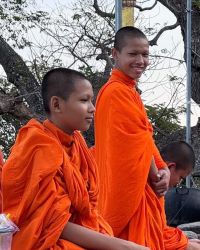Khmer in Laos

Photo Source:
Anonymous
|
Send Joshua Project a map of this people group.
|
| People Name: | Khmer |
| Country: | Laos |
| 10/40 Window: | Yes |
| Population: | 7,900 |
| World Population: | 17,598,700 |
| Primary Language: | Khmer |
| Primary Religion: | Buddhism |
| Christian Adherents: | 3.00 % |
| Evangelicals: | 1.60 % |
| Scripture: | Complete Bible |
| Ministry Resources: | Yes |
| Jesus Film: | Yes |
| Audio Recordings: | Yes |
| People Cluster: | Mon-Khmer |
| Affinity Bloc: | Southeast Asian Peoples |
| Progress Level: |
|
Introduction / History
According to a Khmer legend, their people came into being from a marital union between an Indian Brahmin priest named Kaundinya I and Princess Soma from Nagaland. Archeologists and linguists believe they arrived in what is now Cambodia about 4,000 years ago, bringing rice cultivation with them. This was one of the first place where they used bronze tools.
The great Khmer Empire, which flourished between the ninth and thirteenth centuries, encompassed present-day Thailand, Cambodia, Laos, and southern Vietnam. Its power declined when the Thai and Vietnamese conquered the Khmer and restricted them to the area that now known as Cambodia.
Some Cambodians moved to Laos to escape the terrors of the Khmer Rouge in the late 1970s. A few Khmer are still living in the southwestern tip of Laos, at the borders of Thailand and Cambodia. They speak Khmer (Cambodian), which is an Eastern Mon-Khmer language. Their language is related to that of the Lao.
What Are Their Lives Like?
Most Khmer in Laos are rural, like the Lao majority. They are usually either fishermen or farmers. Rice is their staple food, and they depend on the abundant rain for their terraced rice fields. A minority of them are urban.
The Cambodians have a simple social structure. Each village has its own chief, and there is no political structure beyond the village. The village chief is the link between the people and the central government. Village leadership is usually divided; the chief has authority in secular matters, while the Buddhist monk has authority regarding religious issues. The Buddhist Wat, or temple, is the center of village life, and Buddhist rules of conduct are used to maintain social control. These rules of conduct include abstaining from lying, stealing, drinking alcoholic beverages, committing adultery, and killing living creatures.
The Cambodians in Laos have gained the languages and cultures of their Laotian neighbors. Ancient Khmer influences on the Lao are strong as well, giving the two groups a common ancestral bond; yet the Lao see the Cambodian as a lower class. The Lao and the Khmer both are still suffering from the use of Agent Orange during the Vietnam War.
Traditional Khmer music reflects a tie to Indonesia. Folk dancing and the classical royal ballet are also popular.
What Are Their Beliefs?
India influenced the former Khmer Empire, from which it adopted Hinduism and Buddhism. Today, most of the Cambodians in Laos are Buddhist. However, relics of ethnic religions such as ancestor worship (praying to deceased ancestors for guidance) and spirit worship are very important to them.
Because of Buddhist influence, Cambodians also seek the middle path to nirvana, or ultimate peace through gaining merit in this life. They believe they can gain merit by supporting the construction of new Buddhist temples, giving food to Buddhist monks, and studying in the monastery. Peasant boys often became monks in order to gain an education in Buddhist monasteries.
What Are Their Needs?
The Khmer need assistance with mainstreaming those with birth defects caused by agent orange 50 years ago. Someone with agricultural expertise could help them increase their crops.
Prayer Points
Pray for an abundant blessing of Khmer families and communities as they embrace Jesus Christ, the Lord of Lords.
Pray for a movement to Christ that will enrich the Khmer community.
Pray for spiritual openness to Jesus Christ that will not be hindered by the false belief in religious institutions rather than the person, Jesus Christ.